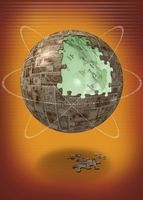End-Time Prophecy Jigsaw: The Pieces Are Falling Into Place!
Written by Ralph Levy
 Let’s consider three of the major prophetic elements that must fall into place before Jesus Christ’s second coming. Where are we now in Bible prophecy?
Let’s consider three of the major prophetic elements that must fall into place before Jesus Christ’s second coming. Where are we now in Bible prophecy?
When will the end of the age be? When will Jesus Christ return? For some two millennia human beings have asked that question (Matthew 24:3; Acts 1:6), only to be told, “Of that day and hour no one knows, not even the angels of heaven, but My Father only” (Matthew 24:36).
Still, we are told to keep watch and that end-time prophecy is like the ripening of figs on a tree. “Now learn this parable from the fig tree: When its branch has already become tender and puts forth leaves, you know that summer is near. So you also, when you see all these things, know that it is near—at the doors!” (Matthew 24:32-33).
Jesus even denounced as hypocrites some of the religious leaders of His day for their inability to discern the significance of events: “Hypocrites! You know how to discern the face of the sky, but you cannot discern the signs of the times” (Matthew 16:3).
Like a jigsaw puzzle
Can we discern the signs of the times, almost 2,000 years later? We may be helped by our childhood experience of jigsaw puzzles. Remember the sense of frustration as you tried to force pieces into places they didn’t belong—and the eventual satisfaction as you suddenly caught on to where each piece belonged?
End-time prophecy is like a jigsaw puzzle. The pieces eventually come together, just as God tells us in the Bible. The picture just prior to the return of Jesus Christ, the Messiah, isn’t a pretty one; in fact, it’s terrifying. “Unless those days were shortened, no flesh would be saved [alive]; but for the elect’s sake those days will be shortened” (Matthew 24:22).
Frightening as it may be, now, in the year 2011, some of those pieces are coming together. Are we watching? What are some of those pieces?
Piece 1: the king of the South
The book of Daniel tells us that in the last days there will be an influential person ruling in the south, that is, in the Mediterranean area and generally south of Jerusalem (Daniel 11).
Historically, this king of the South was the dynastic leader of the Ptolemies, or the Egyptian branch of the Greek Empire. The king of the South battled it out for over a century, as the Egypt-based Ptolemies struggled for supremacy against the Syria-based Seleucids, another branch of the Greek Empire. This took place in the third and second centuries B.C., after the death of Alexander the Great in 323 B.C. (Daniel 11:3-4).
Yet this same prophecy suddenly takes a huge leap to “the time of the end,” when we find a latter-day king of the South provoking and fighting against the king of the North (Daniel 11:40).
We are apparently witnessing the shake-up that will make possible the formation of that southern alliance right now in the Muslim world. The “Arab spring” of 2011 began with the fall of President Zine El Abidine Ben Ali of Tunisia in January, followed by the ouster of Hosni Mubarak of Egypt. And now apparently the third domino to fall is Colonel Muammar Gaddafi of Libya. As I write it appears the miserable 42-year dictatorship of Muammar Gaddafi is coming to a bloody end, with insurgents taking control of much of the capital of Tripoli after six months of civil war.
Who’s next? Syria? Yemen? Maybe even some of the hitherto relatively tranquil Arab monarchies, such as Jordan, Morocco, perhaps even Saudi Arabia? Time will tell.
What needs to be watched closely is the fulfillment of the West’s “nightmare scenario”: that these Arab nations will eventually unite under the banner of radical Islam. While it’s true that many in these countries don’t want that, it’s the Islamists who have the advantage over the other parties by being best organized. Just as the Islamists outmaneuvered the others in their anti-shah alliance in Iran in 1979, so they seem likely to succeed in these Arab nations.
This is all looking strikingly like the emergence of the king of the South, foretold some 2,600 years ago by the prophet Daniel. It’s essential for the fulfillment of end-time prophecy—and a critical piece in the jigsaw!
Piece 2: the king of the North
Daniel’s prophecy tells us that once this end-time king of the South has provoked the king of the North, the latter will swoop down on him with massive military force, and invade and conquer much of the Middle East (Daniel 11:40-43).
Elsewhere in Bible prophecy, the king of the North is referred to as “the beast,” the name assigned him by the apostle John in the book of Revelation (Revelation 13:1-10; 17:3-17). We know from history that the heart of this massive end-time power will be in central Europe. In fact, much of the history of the Middle Ages reflects the struggle for dominance between Catholic Europe and the Muslim world, a struggle destined to reappear just before the second coming of Christ.
The economic instability of Europe and particularly the huge strains and stresses now affecting the eurozone seem very likely to point us to the second piece of this jigsaw puzzle: the emergence of a giant economic-military-political-religious power based in Europe.
 Consider: The euro, once hailed as the great key to European prosperity and stability, is on the rocks. Weak peripheral eurozone countries, such as Greece, Portugal and Ireland, are struggling economically. The weakest of the weak, Greece, has really come to the point of technical default on its debt.
Consider: The euro, once hailed as the great key to European prosperity and stability, is on the rocks. Weak peripheral eurozone countries, such as Greece, Portugal and Ireland, are struggling economically. The weakest of the weak, Greece, has really come to the point of technical default on its debt.
Even hitherto strong nations, such as Italy, Spain and France, are coming under pressure, as the German economy powers ahead, fueled by resurgent demand for its quality heavy engineering products. German bonds are snapped up, seen as a safe haven from economic storms on both sides of the Atlantic.
Meantime, the differential between the strength of Germany and the weakness of its eurozone partners grows, as evidenced by desperate measures to bring stability to the European Union and to compensate for the fact that some of its nation-states are growing stronger economically, while others appear to be drowning.
And what has been unthinkable in the years since World War II is beginning to appear—a stirring of German nationalism. The people of this most-populous and most-prosperous central European nation understandably have begun to ask why they have to bail out their weaker cousins.
How long can the tension continue? How long till new, more strident leadership appears in central Europe, reflecting the frustration of people weary of constant calls to come to the aid of weaker economies? This piece of the jigsaw is yet to fall into place, but its placement is beginning to seem ominously close.
Piece 3: the battle for Jerusalem
Jerusalem is said to be the city with a heart of gold. Yet it is also the city that has brought much contention and strife down through the ages, beginning around the time of King David. The prophet Ezekiel tells us that God set Jerusalem “in the midst of the nations and the countries all around her” (Ezekiel 5:5). Its location made it essential to trade, as well as political dominance, in the ancient world.
It remains a center of contention today. With the eastern half conquered in 1967, it remains the “eternal and undivided capital” of the Jewish state, according to the state of Israel, while the Palestinians demand the eastern half as the capital of their future state.
Its importance to the three major monotheistic religions makes it a tense place, with conflicting claims to various holy sites. Bible prophecy identifies it as the center of the Kingdom of God; but some believe the Kingdom of God to be embodied in a religious structure today. This provides a theological claim to the city now, and sows the seed of conflict that will cause strife over the city.
Note Zechariah’s prophecy about this city: “For I will gather all the nations to battle against Jerusalem; the city shall be taken, the houses rifled, and the women ravished. Half of the city shall go into captivity, but the remnant of the people shall not be cut off from the city. Then the LORD will go forth and fight against those nations. … And in that day His [Messiah’s] feet will stand on the Mount of Olives, which faces Jerusalem on the east” (Zechariah 14:2-4).
Ultimately this city will belong to Jesus Christ, who will put down rebellion and from there establish His rule over all the earth.
But not before one last attempt by the kingdoms of this world to grab the city. “But when you see Jerusalem surrounded by armies, then know that its desolation is near. … And Jerusalem will be trampled by Gentiles until the times of the Gentiles are fulfilled” (Luke 21:20, 24).
The end of the “times of the Gentiles” and the trampling down of the city of Jerusalem—this is a piece of the jigsaw that hasn’t yet fallen into place. Yet the “Arab spring” brings it closer, as new and unpredictable developments take hold in the Arab world, which will eventually contribute to the encircling of Jerusalem and its conquest just before the second coming of Jesus Christ.
How long?
How long will all this take? Sometimes when we as young people enjoyed our jigsaw puzzles, the pieces fell into place smoothly and easily. At other times, one or more pieces seemed to resist our best efforts.
So it is with this jigsaw. It may move fast or it may move slowly, according to the One who governs in the affairs of humans, the Creator God. Yet we must make no mistake: These things are certain; and in God’s time, sooner or later, they will come to pass!
 Keep your eyes open as the jigsaw comes together!
Keep your eyes open as the jigsaw comes together!
Ralph Levy is a minister of the Church of God, a Worldwide Association, who grew up in England and now lives in the United States. Dr. Levy enjoys serving the Church, reading, travel and foreign languages. He has a Ph.D. in biblical studies and has worked in foreign language and religious education for much of his professional life.
Related links:
- Frequently Asked Questions Prophecy category
- Three Purposes of Prophecy
- Understanding End-Time Prophecy
- Europe Rising From Confusion Toward Unity?
- The Mark of the Beast Is No Laughing Matter
- What's Next for Egypt?








